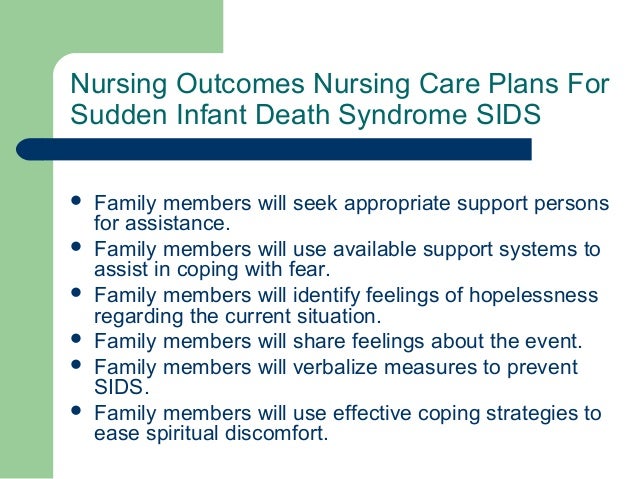NCP Nursing Care Plans For Sudden Infant Death Syndrome SIDS. Sudden infant death syndrome (SIDS), also known as crib death, is the third leading cause of death among apparently healthy infants between ages 1 month to 1 year. In 2002, SIDS caused 2,295 infant deaths, accounting for 8.2% of total infant deaths that year. Most deaths occur between ages 1 and 4 months, with incidence declining rapidly between ages of 4 to 12 months.
About 60% of victims are male infants who die in their sleep, without warning, sound, or struggle. The incidence is slightly higher in preterm infants, Inuit infants, disadvantaged black infants, infants born to mothers younger than age 20, and infants of multiple births.
Causes For Sudden Infant Death Syndrome SIDS
At one time, SIDS was attributed to abuse or accidental suffocation during sleep. On postmortem examination, some SIDS-diagnosed infants show changes indicating chronic hypoxia, hypoxemia, and large-airway obstruction, leading researchers to suspect more than one cause.
Two leading hypotheses are the hypoxemia theory and the apnea theory. The hypoxemia theory suggests that SIDS occurs because of damage to the respiratory control center in the brain from chronic hypoxemia. The apnea theory holds that the SIDS victim experiences prolonged periods of sleep apnea and eventually dies during an episode.
Another proposed cause involves Clostridium botulinum toxin, which has been linked to a few SIDS deaths. A disproved theory is an association between SIDS and diphtheria, tetanus, and pertussis vaccines. And, although bottle-feeding and advanced parental age don't cause the syndrome, breast-fed infants are at decreased risk for SIDS
Nursing Assessment Nursing Care Plans For Sudden Infant Death Syndrome SIDS
The patient history supplied by the parents may reveal that they found the infant wedged in a crib corner or with blankets wrapped around his head. Despite such findings, autopsy results rule out suffocation as the cause of death. The history may also note frothy, blood-tinged sputum found around the infant's mouth or on the crib sheets. However, autopsy findings show a patent airway, ruling out aspiration of vomitus as the cause of death.
Typically, the parents report that the infant didn't cry and showed no signs of disturbed sleep. Reports of the infant found in a peculiar position or tangled in his blankets suggest movement before death, possibly from terminal spasm. Occasionally, the history may reveal a respiratory tract infection.
Documentation of events before discovery of the infant's death should be part of the history. Often, bruising, possible fractured ribs, and the appearance of blood in the infant's mouth, nose, or ears from internal bleeding may be confused with abuse. Although this possibility shouldn't be dismissed, never assume that abuse caused the infant's death without obtaining further information. Avoid assessment questions that may suggest parental responsibility for the death.
Depending on how long the infant has been dead, inspection may reveal an infant with mottled complexion and extremely cyanotic lips and fingertips. You may also see pooled blood in the legs and feet. These markings may be mistaken for bruises. The infant's diaper may be wet and full of stools.
Diagnostic tests For Sudden Infant Death Syndrome SIDS
Diagnosis of SIDS requires an autopsy to rule out other causes of death. Characteristic histologic findings on autopsy include small or normal adrenal glands and petechiae over the visceral surfaces of the pleura, within the thymus (which is enlarged), and in the epicardium. Autopsy also reveals well-preserved lymphoid structures; signs of chronic hypoxemia such as increased pulmonary artery smooth muscle; edematous, congestive lungs fully expanded; liquid (not clotted) blood in the heart; and stomach curd inside the trachea
Nursing Diagnosis Nursing Care Plans For Sudden Infant Death Syndrome SIDS
- Dysfunctional grieving
- Fear
- Hopelessness
- Interrupted family processes
- Spiritual distress
Nursing Outcomes Nursing Care Plans For Sudden Infant Death Syndrome SIDS
- Family members will seek appropriate support persons for assistance.
- Family members will use available support systems to assist in coping with fear.
- Family members will identify feelings of hopelessness regarding the current situation.
- Family members will share feelings about the event.
- Family members will verbalize measures to prevent SIDS.
- Family members will use effective coping strategies to ease spiritual discomfort.
Nursing Interventions NCP Nursing Care Plans For Sudden Infant Death Syndrome SIDS
- Grief Work Facilitation: Assistance with the resolution of a significant loss
- Grief Work Facilitation: Perinatal Death: Assistance with the resolution of a perinatal loss
- Coping Enhancement: Assisting a patient to adapt to perceived stressors, changes, or threats that interfere with meeting life demands and roles
- Anxiety Reduction: Minimizing apprehension, dread, foreboding, or uneasiness related to an unidentified source or anticipated danger
- Security Enhancement: Intensifying a patient’s sense of physical and psychological safety
- Hope Instillation: Facilitation of the development of a positive outlook in a given situation
- Emotional Support: Provision of reassurance, acceptance, and encouragement during times of stress
- Family Process Maintenance: Minimization of family process disruption effects
- Family Integrity Promotion: Facilitating family participation in the emotional and physical care of the patient
- Normalization Promotion: Assisting parents and other family members of children with chronic diseases or disabilities in providing normal life experiences for their children and families
- Spiritual Support: Assisting the patient to feel balance and connection with a greater power
- Grief Work Facilitation: Assistance with the resolution of a significant loss
